The Characteristics of the Spatial and Temporal Distribution of the Initial Compression Wave Induced by a 400 km/h High-Speed Train Entering a Tunnel
Abstract
:1. Introduction
2. Methodology
2.1. Geometric Model
2.2. Computational Domain and Boundary Conditions
2.3. Meshing Strategy
2.4. Numerical Method
2.5. Mesh-Independent and Numerical Methods Validation
3. Results and Discussion
3.1. The Generation Mechanism of the Initial Compression Wave
3.2. The One-Dimensional and Three-Dimensional Characteristics of the Initial Compression Wave
3.3. The Identification of One-Dimensional Waveform of the Entire Initial Compression Wave
3.4. The Influence of Train Running Position on the Initial Compression Wave
3.4.1. Comparison of the Transition Process of the Initial Compression Wave from Three-Dimensional Wave to One-Dimensional Wave
3.4.2. Comparison of the Waveforms
4. Conclusions
Author Contributions
Funding
Institutional Review Board Statement
Informed Consent Statement
Data Availability Statement
Conflicts of Interest
References
- Dai, Z.; Li, T.; Zhang, W.; Zhang, J. Investigation on aerodynamic characteristics of high-speed trains with shields beneath bogies. J. Wind. Eng. Ind. Aerodyn. 2024, 246, 105666. [Google Scholar] [CrossRef]
- Mou, R.; Chen, C.; Chen, C.; Zhang, Y. Analysis and control of high-speed train lateral vibration on the basis of a conditionally triggered model predictive control strategy. J. Mech. Sci. Technol. 2024, 38, 1703–1717. [Google Scholar] [CrossRef]
- Baker, C.J. A review of train aerodynamics Part 1—Fundamentals. Aeronaut. J. 2014, 118, 201–228. [Google Scholar] [CrossRef]
- Niu, J.; Sui, Y.; Yu, Q.; Cao, X.; Yuan, Y. Aerodynamics of railway train/tunnel system: A review of recent research. Energy Built Environ. 2020, 1, 351–375. [Google Scholar] [CrossRef]
- Ozawa, S. Studies of micro-pressure wave radiated from a tunnel exit. Railw. Tech. Res. Rep. 1979, 1121, 1–92. (In Japanese) [Google Scholar]
- Vardy, A.E. Generation and alleviation of sonic booms from rail tunnels. Proc. Inst. Civ. Eng.-Eng. Comput. Mech. 2008, 161, 107–119. [Google Scholar] [CrossRef]
- Baron, A.; Molteni, P.; Vigevano, L. High-speed trains: Prediction of micro-pressure wave radiation from tunnel portals. J. Sound Vib. 2006, 296, 59–72. [Google Scholar] [CrossRef]
- Zhang, G.; Kim, T.H.; Kim, D.H.; Kim, H.D. Prediction of micro-pressure waves generated at the exit of a model train tunnel. J. Wind. Eng. Ind. Aerodyn. 2018, 183, 127–139. [Google Scholar] [CrossRef]
- Aoki, T.; Vardy, A.; Brown, J. Passive alleviation of micro-pressure waves from tunnel portals. J. Sound Vib. 1999, 220, 921–940. [Google Scholar] [CrossRef]
- Fukuda, T.; Ozawa, S.; Iida, M.; Takasaki, T.; Wakabayashi, Y.; Miyachi, T. Propagation of Compression Wave in a Long Tunnel with Slab Tracks. Q. Rep. RTRI 2005, 46, 188–193. [Google Scholar] [CrossRef]
- Tebbutt, J.; Vahdati, M.; Carolan, D.; Dear, J. Numerical investigation on an array of Helmholtz resonators for the reduction of micro-pressure waves in modern and future high-speed rail tunnel systems. J. Sound Vib. 2017, 400, 606–625. [Google Scholar] [CrossRef]
- Kwon, H.-B.; Jang, K.-H.; Kim, Y.-S.; Yee, K.-J.; Lee, D.-H. Nose Shape Optimization of High-speed Train for Minimization of Tunnel Sonic Boom. JSME Int. J. Ser. C Mech. Syst. Mach. Elem. Manuf. 2001, 44, 890–899. [Google Scholar] [CrossRef]
- Auvity, B.; Bellenoue, M. Effects of an opening on pressure wave propagation in a tube. J. Fluid Mech. 2005, 538, 269–289. [Google Scholar] [CrossRef]
- Zhang, L.; Thurow, K.; Stoll, N.; Liu, H. Influence of the geometry of equal-transect oblique tunnel portal on com-pression wave and micro-pressure wave generated by high-speed trains entering tunnels. J. Wind. Eng. Ind. Aerodyn. 2018, 178, 1–17. [Google Scholar] [CrossRef]
- Mashimo, S.; Nakatsu, E.; Aoki, T.; Matsuo, K. Attenuation and Distortion of a Compression Wave Propagating in a High-Speed Railwav Tunnel. JSME Int. J. Ser. B Fluids Therm. Eng. 1997, 40, 51–57. [Google Scholar] [CrossRef]
- Wang, H.; Lei, B.; Bi, H.; Yu, T. Wavefront evolution of compression waves propagating in high speed railway tunnels. J. Sound Vib. 2018, 431, 105–121. [Google Scholar] [CrossRef]
- Iyer, R.S.; Kim, D.H.; Kim, H.D. Propagation characteristics of compression wave in a high-speed railway tunnel. Phys. Fluids 2021, 33, 086104. [Google Scholar] [CrossRef]
- Miyachi, T.; Ozawa, S.; Fukuda, T.; Iida, M.; Arai, T. A New Simple Equation Governing Distortion of Compression Wave Propagating Through Shinkansen Tunnel with Slab Tracks. J. Fluid Sci. Technol. 2013, 8, 462–475. [Google Scholar] [CrossRef]
- Li, G.-Z.; Ye, X.; Deng, E.; Yang, W.-C.; Ni, Y.-Q.; He, H.; Ao, W.-K. Aerodynamic mechanism of a combined buffer hood for mitigating micro-pressure waves at the 400 km/h high-speed railway tunnel portal. Phys. Fluids 2023, 35, 126106. [Google Scholar] [CrossRef]
- Kim, B.; Ahn, J.; Kwon, H. Numerical study of the effect of the tunnel hood on micro-pressure wave for increasing high-speed train operation speed. J. Mech. Sci. Technol. 2024, 38, 721–733. [Google Scholar] [CrossRef]
- Hara, T. Aerodynamic Force Acting on a High Speed Train at Tunnel Entrance. Bull. JSME 1961, 4, 547–553. [Google Scholar] [CrossRef]
- Howe, M.S. The compression wave produced by a high-speed train entering a tunnel. Proc. R. Soc. Lond. Ser. A Math. Phys. Eng. Sci. 1998, 454, 1523–1534. [Google Scholar] [CrossRef]
- Howe, M.; Iida, M.; Fukuda, T. Influence of an unvented tunnel entrance hood on the compression wave generated by a high-speed train. J. Fluids Struct. 2003, 17, 833–853. [Google Scholar] [CrossRef]
- Howe, M.S.; Iida, M.; Fukuda, T.; Maeda, T. Theoretical and experimental investigation of the compression wave generated by a train entering a tunnel with a flared portal. J. Fluid Mech. 2000, 425, 111–132. [Google Scholar] [CrossRef]
- Howe, M.; Iida, M.; Maeda, T.; Sakuma, Y. Rapid calculation of the compression wave generated by a train entering a tunnel with a vented hood. J. Sound Vib. 2006, 297, 267–292. [Google Scholar] [CrossRef]
- Howe, M.; Winslow, A.; Iida, M.; Fukuda, T. Rapid calculation of the compression wave generated by a train entering a tunnel with a vented hood: Short hoods. J. Sound Vib. 2007, 311, 254–268. [Google Scholar] [CrossRef]
- Bellenoue, M.; Morinière, V.; Kageyama, T. Experimental 3-d simulation of the compression wave, due to train–tunnel entry. J. Fluids Struct. 2002, 16, 581–595. [Google Scholar] [CrossRef]
- Wang, T.; Chen, J.; Wang, J.; Shi, F.; Zhang, L.; Qian, B.; Jiang, C.; Wang, J.; Wang, Y.; Yang, M. Three-dimensional characteristics of pressure waves induced by high-speed trains passing through tunnels. Acta Mech. Sin. 2024, 40, 323261. [Google Scholar] [CrossRef]
- Kikuchi, K.; Iida, M.; Fukuda, T. Optimization of Train Nose Shape for Reducing Micro-Pressure Wave Radiated from Tunnel Exit. J. Low Freq. Noise Vib. Act. Control 2011, 30, 1–19. [Google Scholar] [CrossRef]
- Ku, Y.C.; Rho, J.H.; Yun, S.H.; Kwak, M.H.; Kim, K.H.; Kwon, H.B.; Lee, D.H. Optimal cross-sectional area dis-tribution of a high-speed train nose to minimize the tunnel micro-pressure wave. Struct. Multidiscip. Optim. 2010, 42, 965–976. [Google Scholar] [CrossRef]
- Miyachi, T.; Kikuchi, K.; Hieke, M. Multistep train nose for reducing micro-pressure waves. J. Sound Vib. 2021, 520, 116665. [Google Scholar] [CrossRef]
- Kim, D.H.; Cheol, S.Y.; Iyer, R.S.; Kim, H.D. A newly designed entrance hood to reduce the micro pressure wave emitted from the exit of high-speed railway tunnel. Tunn. Undergr. Space Technol. 2020, 108, 103728. [Google Scholar] [CrossRef]
- Okubo, H.; Miyachi, T.; Fukuda, T. Field test for micro-pressure wave reduction measurement by area optimization of windows of tunnel hoods. Proc. Inst. Mech. Eng. Part F J. Rail Rapid Transit 2022, 236, 1262–1270. [Google Scholar] [CrossRef]
- Ma, W.; Fang, Y.; Li, T.; Shao, M. Alleviation Effects of Hoods at the Entrances and Exits of High-Speed Railway Tunnels on the Micro-Pressure Wave. Appl. Sci. 2024, 14, 692. [Google Scholar] [CrossRef]
- Wang, T.; Feng, Z.; Lu, Y.; Gong, Y.; Zhu, Y.; Zhao, C.; Zhang, L.; Shi, F.; Wang, Y. Study on the mitigation effect of a new type of connected structure on micro-pressure waves around 400 km/h railway tunnel exit. J. Wind. Eng. Ind. Aerodyn. 2023, 240, 105510. [Google Scholar] [CrossRef]
- Niu, J.; Zhou, D.; Liu, F.; Yuan, Y. Effect of train length on fluctuating aerodynamic pressure wave in tunnels and method for determining the amplitude of pressure wave on trains. Tunn. Undergr. Space Technol. 2018, 80, 277–289. [Google Scholar] [CrossRef]
- Li, W.-H.; Liu, T.-H.; Martinez-Vazquez, P.; Xia, Y.-T.; Chen, Z.-W.; Guo, Z.-J. Aerodynamic effects on a railway tunnel with partially changed cross-sectional area. J. Cent. South Univ. 2022, 29, 2589–2604. [Google Scholar] [CrossRef]
- Luo, J.; Wang, L.; Shang, S.; Li, F.; Guo, D.; Gao, L.; Wang, D. Study of unsteady aerodynamic performance of a high-speed train entering a double-track tunnel under crosswind conditions. J. Fluids Struct. 2023, 118, 103836. [Google Scholar] [CrossRef]
- Wang, T.; Zhu, Y.; Tian, X.; Shi, F.; Zhang, L.; Lu, Y. Design method of the variable cross-section tunnel focused on improving passenger pressure comfort of trains intersecting in the tunnel. J. Affect. Disord. 2022, 221, 109336. [Google Scholar] [CrossRef]
- Liu, Z.; Chen, G.; Zhou, D.; Wang, Z.; Guo, Z. Numerical investigation of the pressure and friction resistance of a high-speed subway train based on an overset mesh method. Proc. Inst. Mech. Eng. Part F J. Rail Rapid Transit 2021, 235, 598–615. [Google Scholar] [CrossRef]
- Lv, D.; Niu, J.; Yao, H. Numerical study on transient aerodynamic characteristics of high-speed trains during the opening of braking plates based on dynamic-overset-grid technology. J. Wind. Eng. Ind. Aerodyn. 2023, 233, 105299. [Google Scholar] [CrossRef]
- Hu, X.; Deng, Z.; Zhang, W. Effect of cross passage on aerodynamic characteristics of super-high-speed evacuated tube transportation. J. Wind. Eng. Ind. Aerodyn. 2021, 211, 104562. [Google Scholar] [CrossRef]
- Liu, Z.; Zhou, D.; Soper, D.; Chen, G.; Hemida, H.; Guo, Z.; Li, X. Numerical investigation of the slipstream charac-teristics of a maglev train in a tunnel. Proc. Inst. Mech. Eng. Part F J. Rail Rapid Transit 2023, 237, 179–192. [Google Scholar] [CrossRef]
- Xiang, X.; Xue, L.; Wang, B.; Zou, W. Mechanism and capability of ventilation openings for alleviating micro-pressure waves emitted from high-speed railway tunnels. J. Affect. Disord. 2018, 132, 245–254. [Google Scholar] [CrossRef]
- Hu, X.; Deng, Z.; Zhang, J.; Zhang, W. Aerodynamic behaviors in supersonic evacuated tube transportation with different train nose lengths. Int. J. Heat Mass Transf. 2021, 183, 122130. [Google Scholar] [CrossRef]
- Hu, X.; Deng, Z.; Zhang, J.; Zhang, W. Effect of tracks on the flow and heat transfer of supersonic evacuated tube maglev transportation. J. Fluids Struct. 2021, 107, 103413. [Google Scholar] [CrossRef]
- Meng, S.; Meng, S.; Wu, F.; Li, X.; Zhou, D. Comparative analysis of the slipstream of different nose lengths on two trains passing each other. J. Wind. Eng. Ind. Aerodyn. 2020, 208, 104457. [Google Scholar] [CrossRef]
- Dong, T.; Liang, X.; Krajnović, S.; Xiong, X.; Zhou, W. Effects of simplifying train bogies on surrounding flow and aerodynamic forces. J. Wind. Eng. Ind. Aerodyn. 2019, 191, 170–182. [Google Scholar] [CrossRef]
- Muld, T.W.; Efraimsson, G.; Henningson, D.S. Flow structures around a high-speed train extracted using Proper Orthogonal Decomposition and Dynamic Mode Decomposition. Comput. Fluids 2012, 57, 87–97. [Google Scholar] [CrossRef]
- Menter, F.R. Two-equation eddy-viscosity turbulence models for engineering applications. AIAA J. 1994, 32, 1598–1605. [Google Scholar] [CrossRef]
- He, K.; Su, X.; Gao, G.; Krajnović, S. Evaluation of LES, IDDES and URANS for prediction of flow around a streamlined high-speed train. J. Wind. Eng. Ind. Aerodyn. 2022, 223, 104952. [Google Scholar] [CrossRef]
- Niu, J.; Wang, Y.; Zhang, L.; Yuan, Y. Numerical analysis of aerodynamic characteristics of high-speed train with different train nose lengths. Int. J. Heat Mass Transf. 2018, 127, 188–199. [Google Scholar] [CrossRef]
- Doi, T.; Ogawa, T.; Masubuchi, T.; Kaku, J. Development of an experimental facility for measuring pressure waves generated by high-speed trains. J. Wind. Eng. Ind. Aerodyn. 2010, 98, 55–61. [Google Scholar] [CrossRef]
- Iida, M.; Tanaka, Y.; Kikuchi, K.; Fukuda, T. Pressure Waves Radiated Directly from Tunnel Portals at Train Entry or Exit. Q. Rep. RTRI 2001, 42, 83–88. [Google Scholar] [CrossRef]


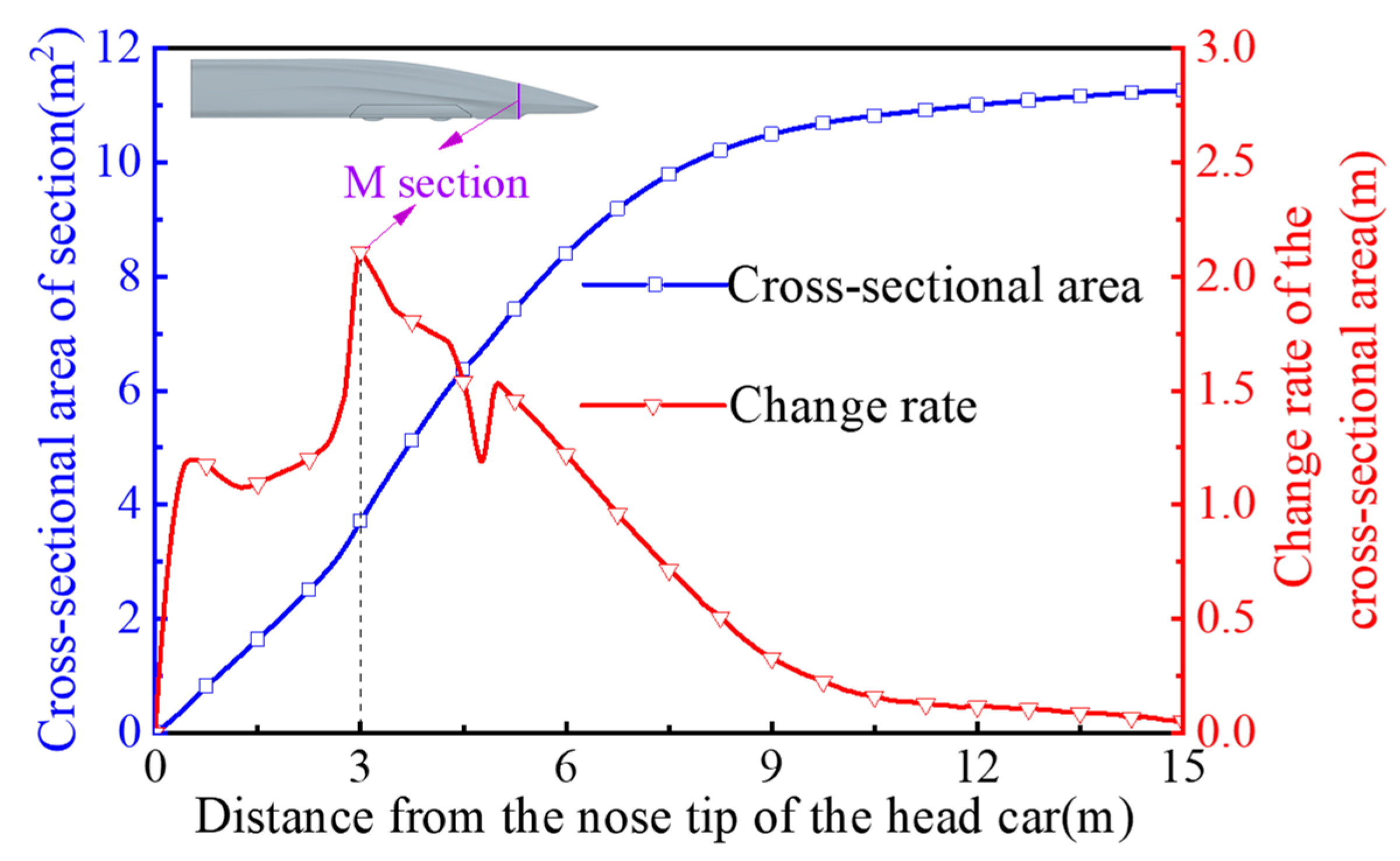




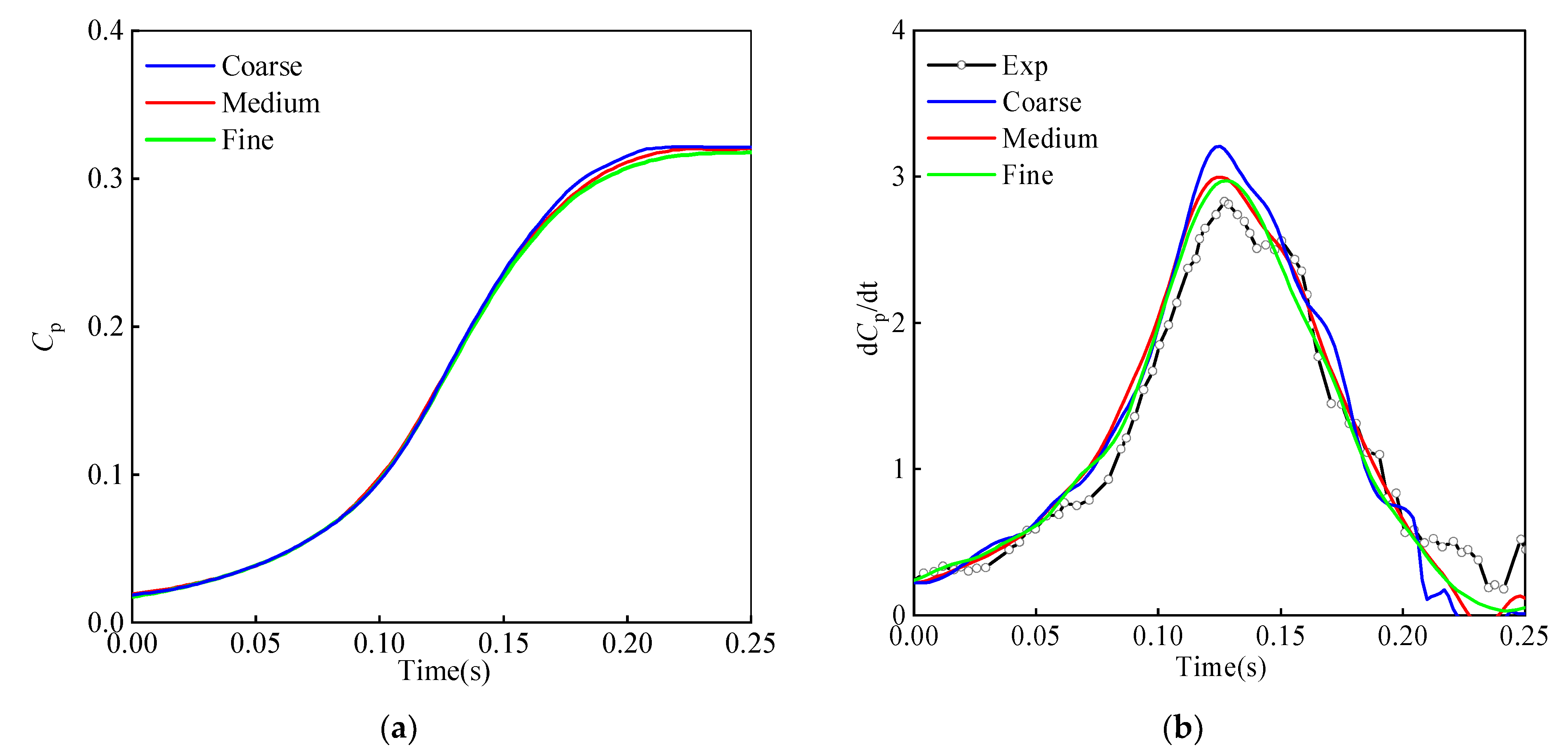
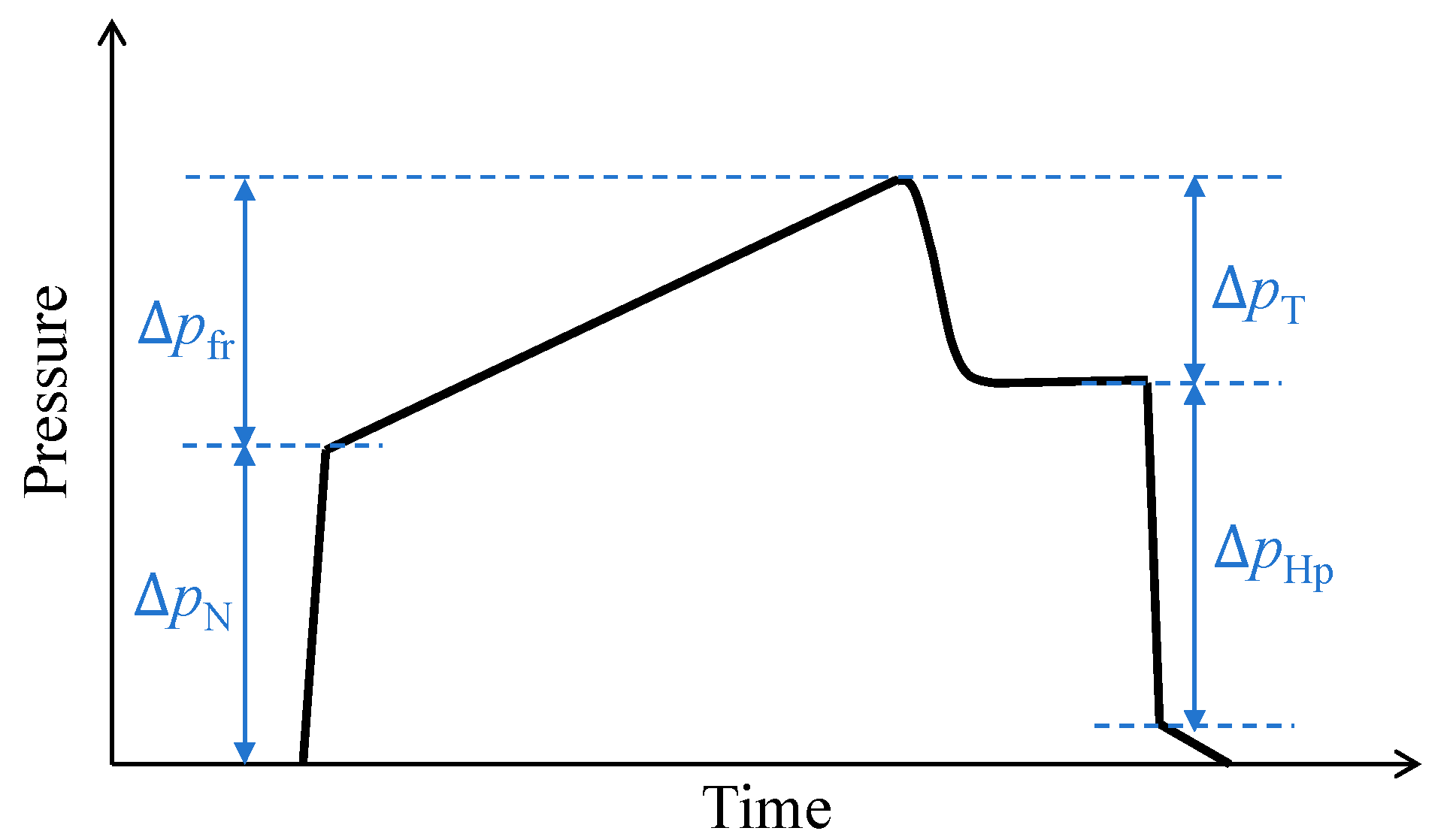
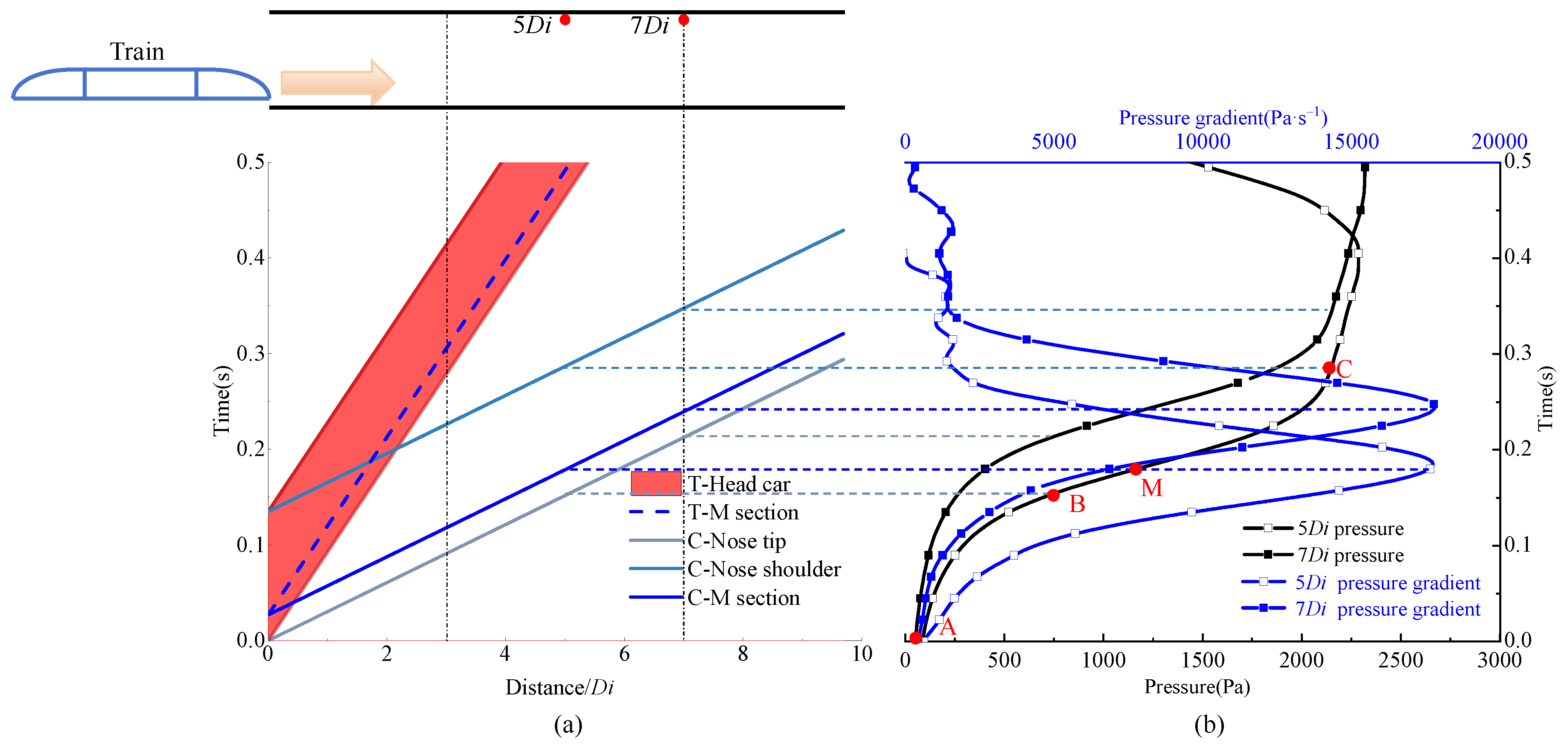
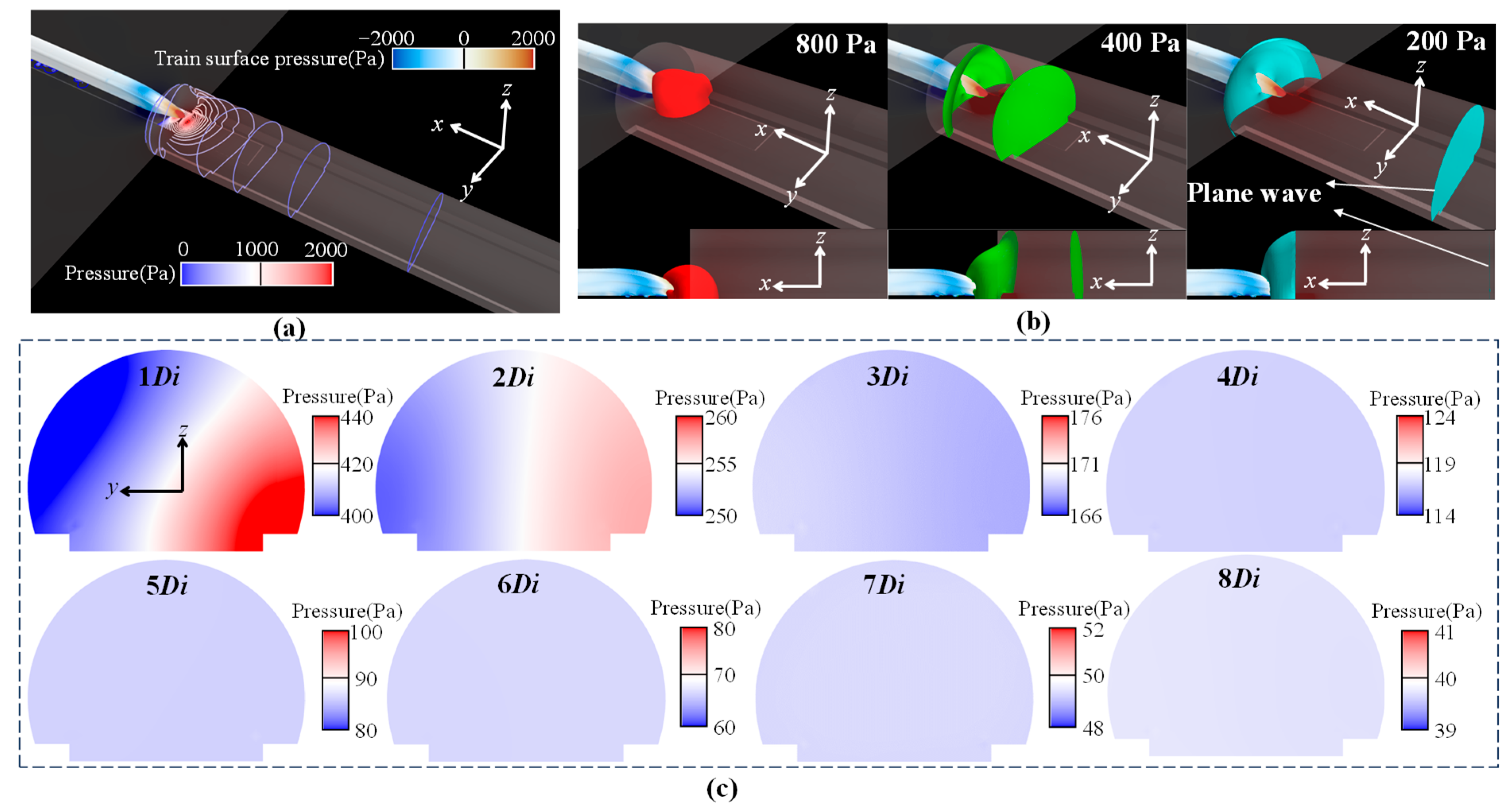
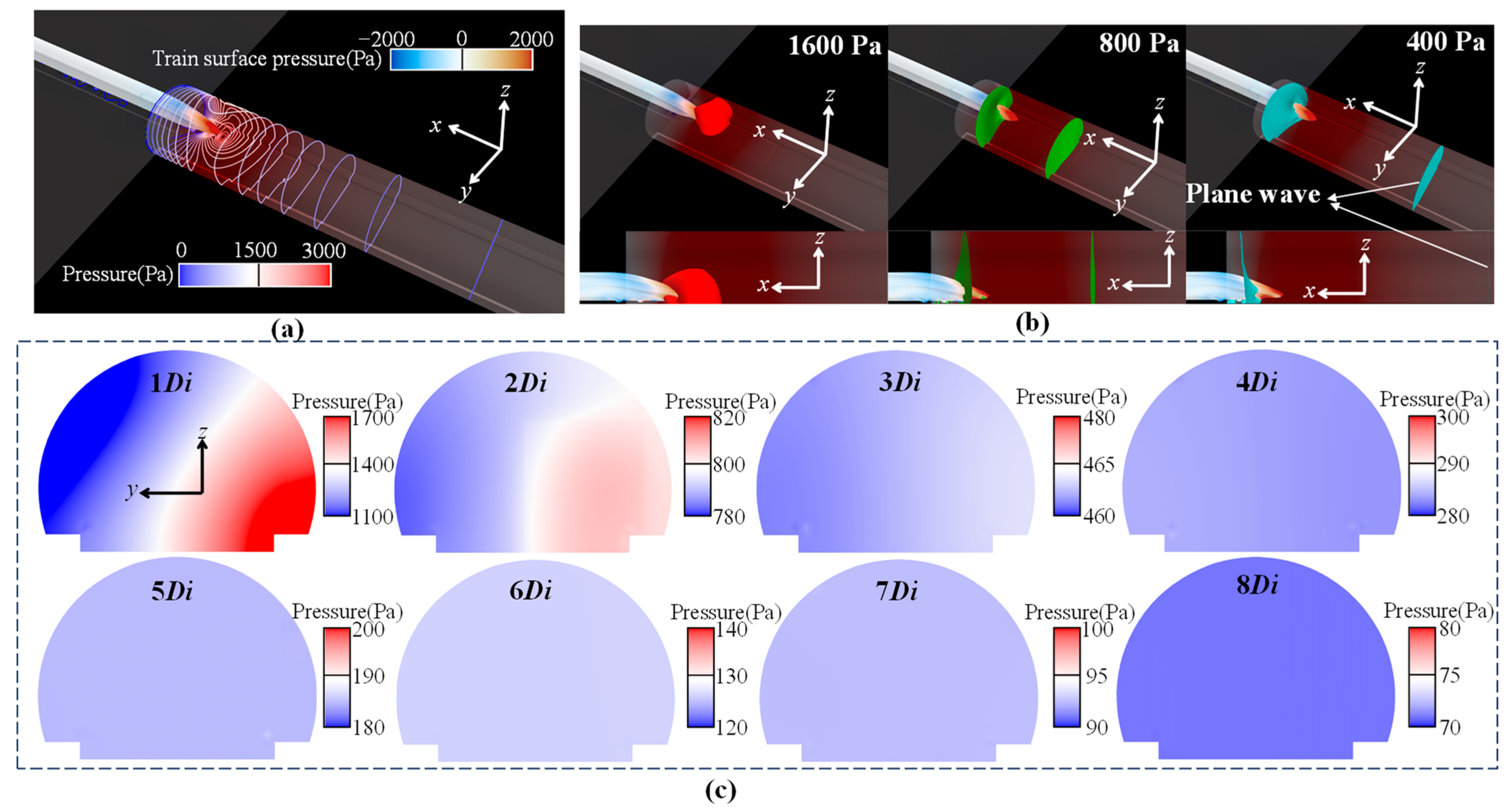
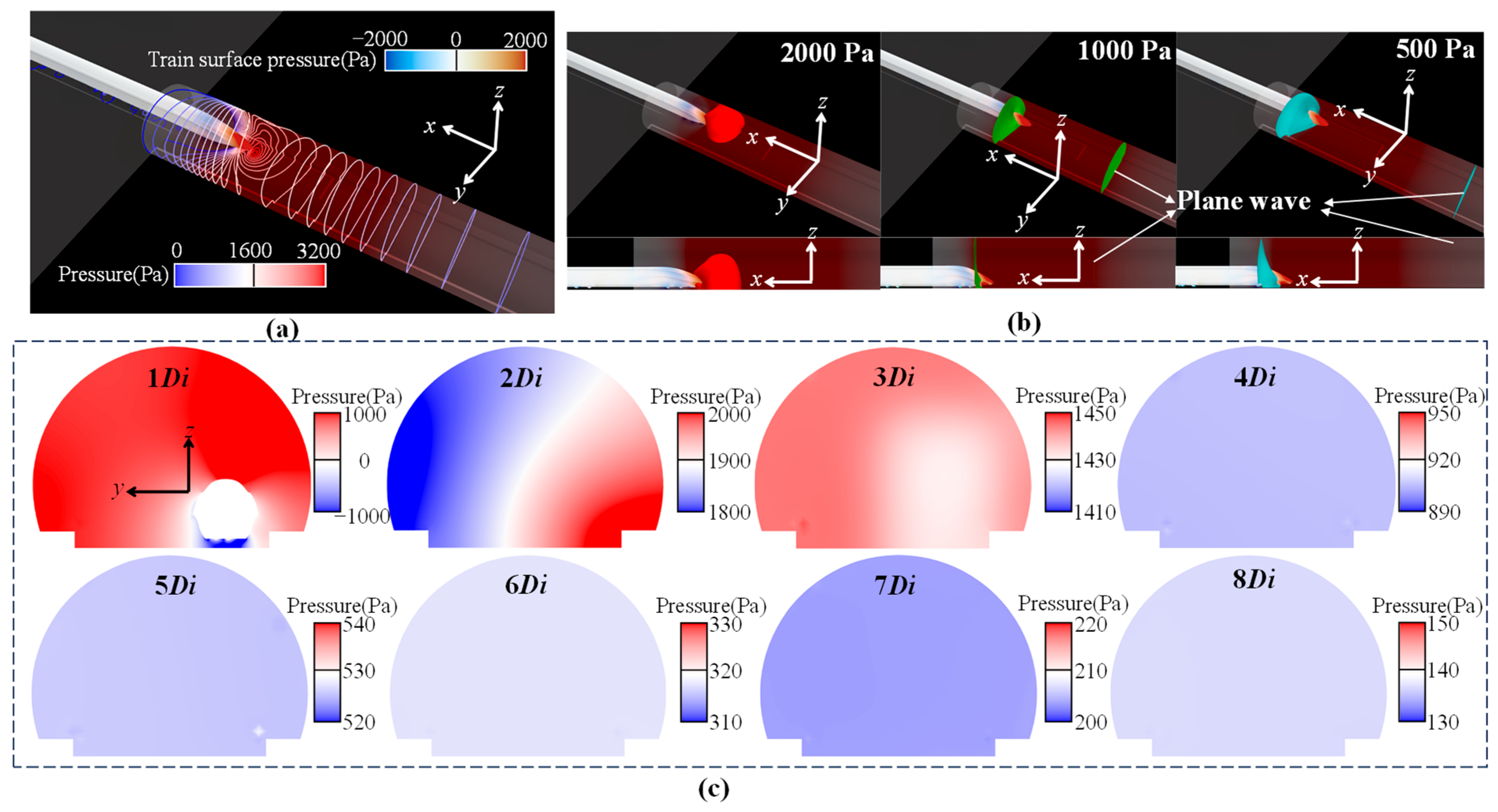



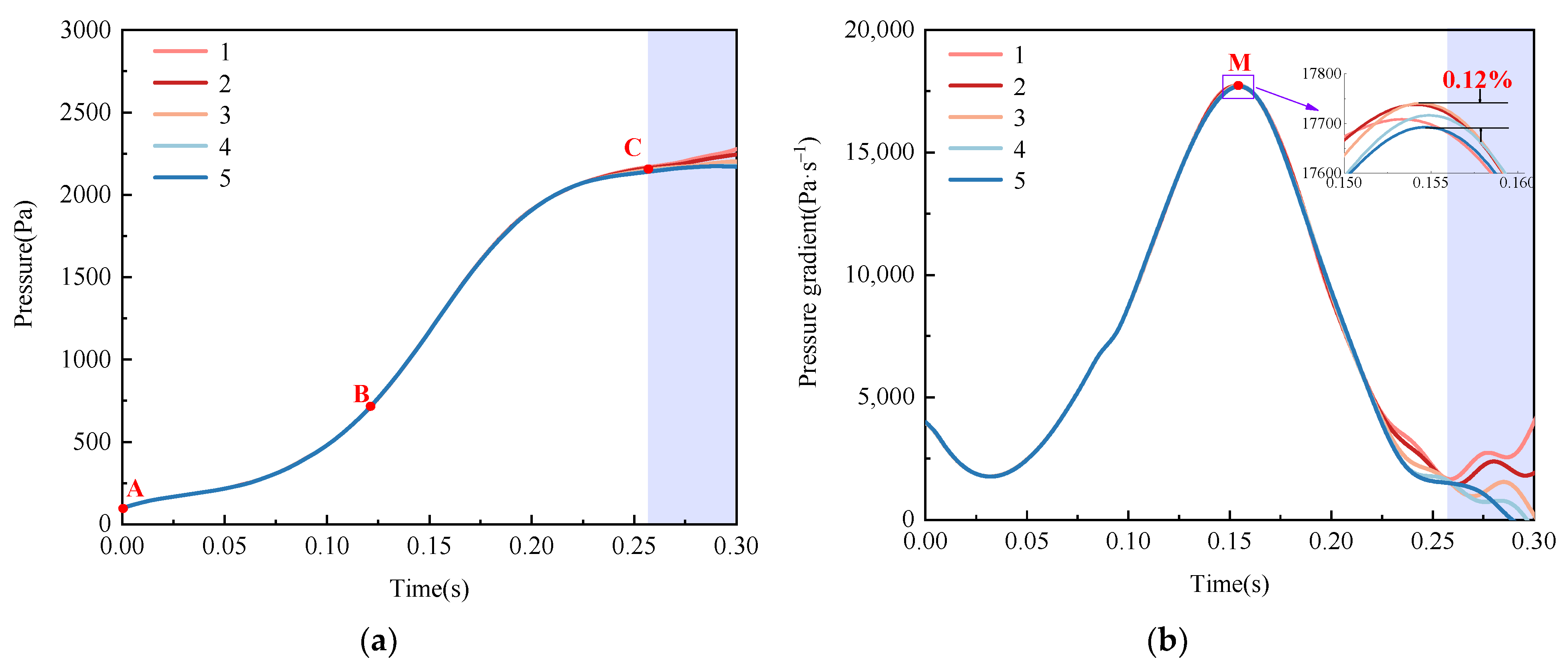

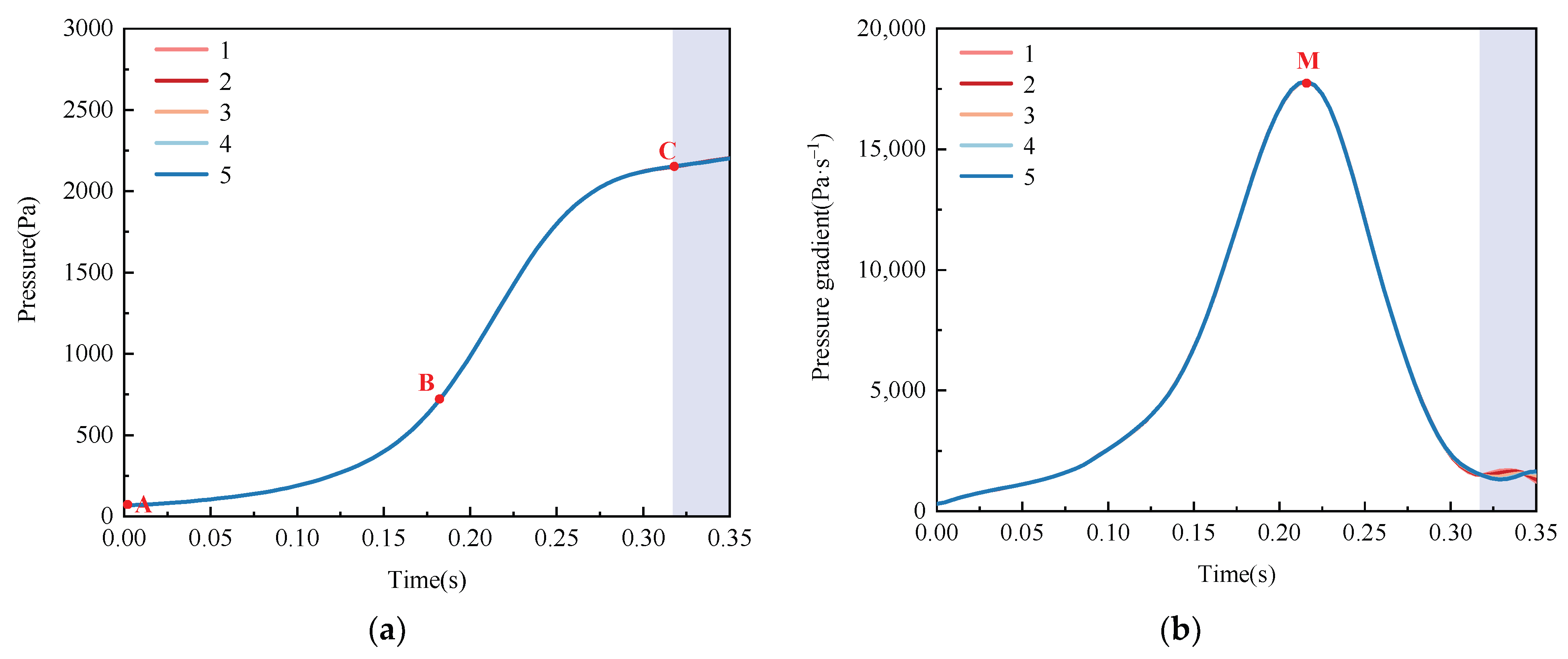

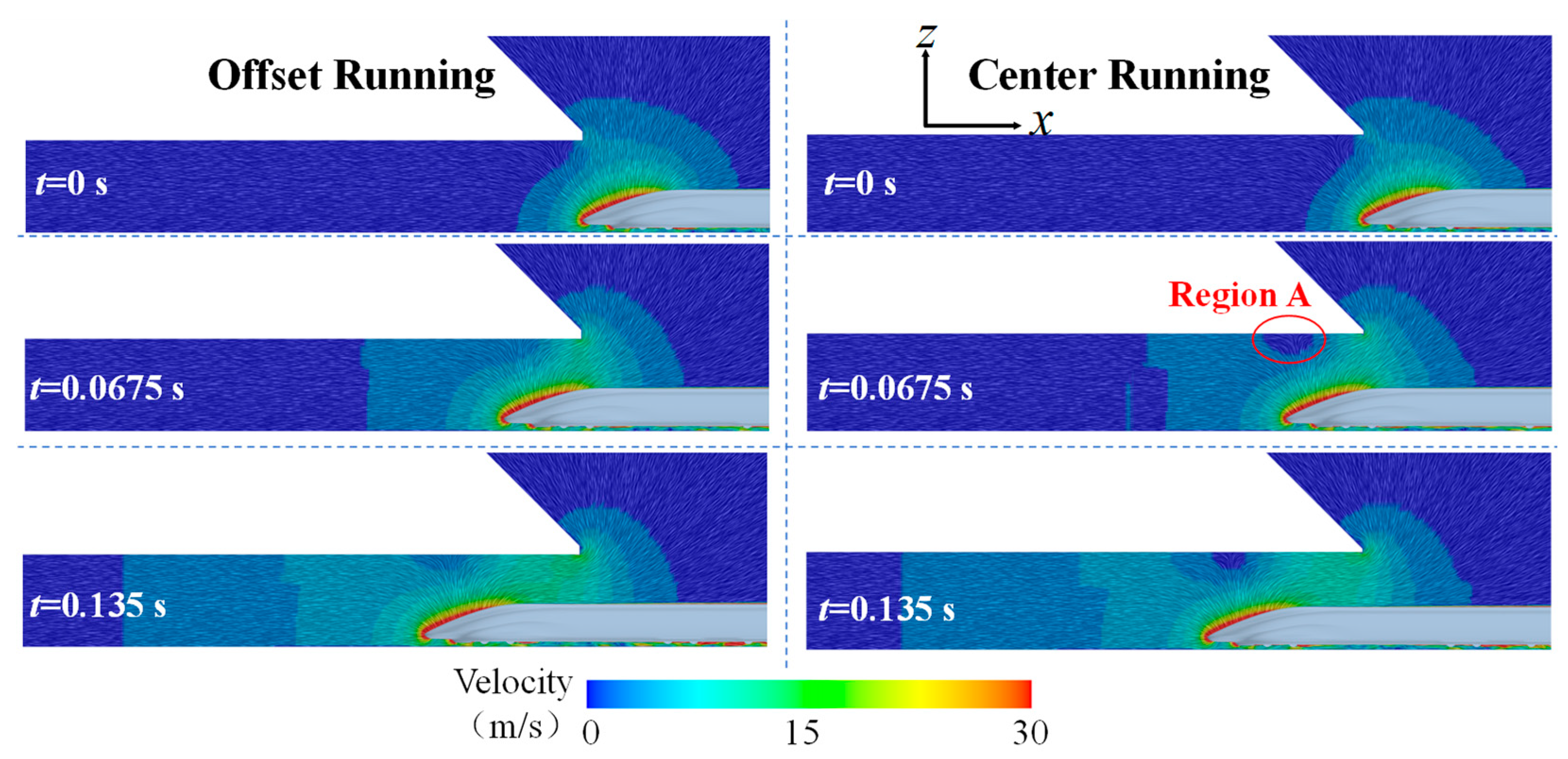

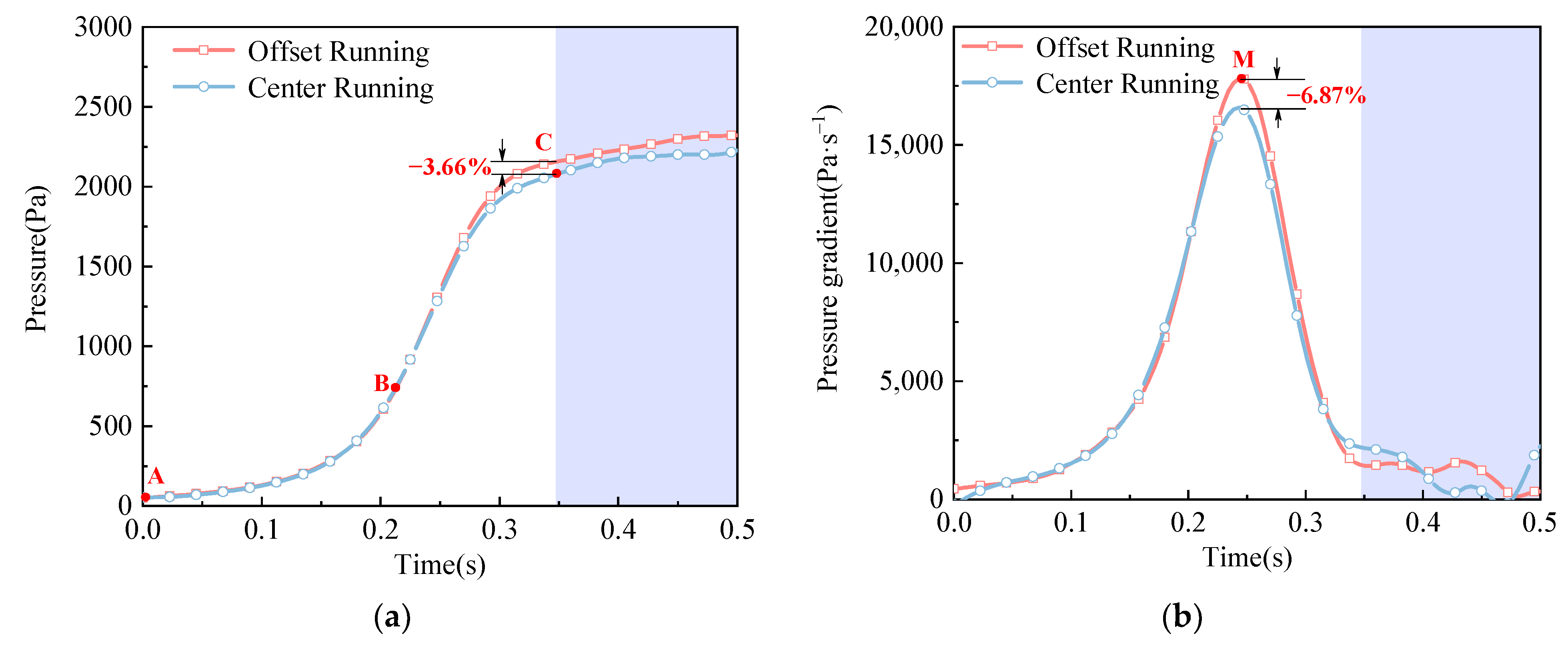
| Case | Coarse | Medium | Fine |
|---|---|---|---|
| Total of cells (million) | 2.49 | 3.96 | 6.90 |
| No. of prism layers | 16 | 16 | 20 |
| Minimum cell size (m) | 0.06 | 0.05 | 0.04 |
| Maximum pressure coefficient gradient | 3.21 | 2.99 | 2.97 |
| Relative error (%) | 13.43 | 5.65 | 4.95 |
| Case | Offset Running | Center Running |
|---|---|---|
| Simulation (Pa) | 2154.11 | 2075.30 |
| Hara’s Formula (Pa) | 2142.71 | |
| Relative Difference (%) | −0.53 | 3.25 |
Disclaimer/Publisher’s Note: The statements, opinions and data contained in all publications are solely those of the individual author(s) and contributor(s) and not of MDPI and/or the editor(s). MDPI and/or the editor(s) disclaim responsibility for any injury to people or property resulting from any ideas, methods, instructions or products referred to in the content. |
© 2024 by the authors. Licensee MDPI, Basel, Switzerland. This article is an open access article distributed under the terms and conditions of the Creative Commons Attribution (CC BY) license (https://creativecommons.org/licenses/by/4.0/).
Share and Cite
Mei, Y.; Wang, Z.; Sun, Q.; Hu, X. The Characteristics of the Spatial and Temporal Distribution of the Initial Compression Wave Induced by a 400 km/h High-Speed Train Entering a Tunnel. Appl. Sci. 2024, 14, 7208. https://doi.org/10.3390/app14167208
Mei Y, Wang Z, Sun Q, Hu X. The Characteristics of the Spatial and Temporal Distribution of the Initial Compression Wave Induced by a 400 km/h High-Speed Train Entering a Tunnel. Applied Sciences. 2024; 14(16):7208. https://doi.org/10.3390/app14167208
Chicago/Turabian StyleMei, Yuangui, Zixian Wang, Qi Sun, and Xiao Hu. 2024. "The Characteristics of the Spatial and Temporal Distribution of the Initial Compression Wave Induced by a 400 km/h High-Speed Train Entering a Tunnel" Applied Sciences 14, no. 16: 7208. https://doi.org/10.3390/app14167208




